DR. OMAR SALEM KHATTAB, MBChB, HDS, HDLM, FICMS, CABS, D.MAS.
LECTURER OF SURGERY, COLLEGE OF MEDICINE, UNIVERSITY OF BAGHDAD, IRAQ
SPECIALIST GENERAL SURGEON, DEP. GENERAL SURGERY, MEDICAL CITY TEACHING HOSPITAL, BAGHDAD, IRAQ
GENERAL AND TRANSPLANT SURGEON, SURGICAL SPECIALITY HOSPITAL, MEDICAL CITY TEACHING HOSPITAL
LECTURER AND MEMBER, CONTINUING MEDICAL EDUCATION CENTER, MEDICAL CITY TEACHING HOSPITAL
Member World Association of Laparoscopic Surgeon (WALS)
Member OF THE PAN-ARAB SOCIETY OF TRAUMA AND EMERGRNCY MEDICINE (PASTEM)
Member OF THE ARAB SOCIETY OF NEPHROLOGY AND RENAL TRANSPLANTATION (ASNRT)
Project to be submitted towards completion of Diploma in Minimal Access Surgery
Abstract:
Background: The development of minimally invasive surgery has promoted new knot elaboration techniques. Yet tying sutures is a challenge. A knot should secure tissue approximation, simple, easy, quick, and reliable. Knots are used since the time of primitive man for trapping animals and making weapons. Today’s laparoscopic knots are basically a modification of knots used by Seamen, Fishermen, Weavers or Hangmen. The aim of this article review is to determine which hand tied knot configuration, suture size, and suture type that would be safe in laparoscopic surgery.
Materials and Methods: A literature review was performed using Springerlink, Pubmed, Highwire press, search engines like Google, and Yahoo. The following search terms were used: extracorporeal knot, laparoscopic knots, laparoscopic tissue approximation, Roeder's knot, Meltzer's knot, Weston knot, Duncan knot, Nicky's knot, SMC knot, Tennes extracorporeal knots and sut see knot. 51,032 citations were found. Selected papers were screened for further references. Publications that featured illustrations of sliding knots , comparing between different ure materials, with statistical methods of analysis, were selected. More than 22 different sliding knots were used for this review.
Result: 104 articles were reviewed. Most studies have evaluated knot security only and few studies have evaluated simultaneous both loop and knot security. The addition of 3 RHAPs improves knot security of all sliding knots tested and improves the loop security of most of the sliding knots tested.
Conclusion: the safety of exrtcorporial knot depends on knot configuration, suture material, and suture size.
key word: extracorporeal knot, tissue approximation, laparoscopic suturing
Introduction:
Despite recent advances in both suture welding and knotless anchor technology, knot tying will remain a necessary skill which the surgeon must master when performing suture anchor in laparoscopic surgery. There are an endless number of combinations of knots (sliding versus static, simple versus complex, etc.) and suture types (monofilament versus braided) to accomplish this task. Surgeons are familiar with knotting but seem not to be aware of the possibilities and impact of the techniques of capsizing, flipping, and flyping knots. (1) Capsizing refers to changing or perverting a flat knot’s geometry under asymmetric stress. The simplest examples of this is the change of the overhand knot into a half-hitch by putting more tension on its one end than on the other (Fig. 1A). (2,3,4) Flipping the knot means to interchange the standing part and working end of the suture, thereby relocating the knot from one end of the suture to the other.(5) The half-hitch can be flipped easily between both ends of a suture (Fig. 1B). Flyping (that rhymes with “typing”) is an archaic Scottish word that was used to describe the peeling off of a very wet glove of the hand, thereby changes its configuration from a right-hand glove to a left-hand one. (6,7,8) The Scottish physicist Peter GuthrieTait (1831-1901) introduced flyping as a knotting term, in the late-19th century, to define this “turning outside in” deformation process of the geometry of knots. (9) An illustrative example of flyping is the change of a series of turns of the working end around the standing part, into the proper blood knot geometry by drawing the proximal turns over the distal ones (Fig. 1C). (7) Ignorance about the techniques of capsizing, flipping, and flyping resulted in the introduction of many allegedly new sliding endoscopic or arthroscopic knots that merely represented configurations of long-known fishing, sailing, or rigger knots. A knot should secure tissue approximation, simple, easy, quick, and reliable. The aim of this article review is to determine which hand tied knot configuration, suture size, and suture type that would be safe in laparoscopic surgery.
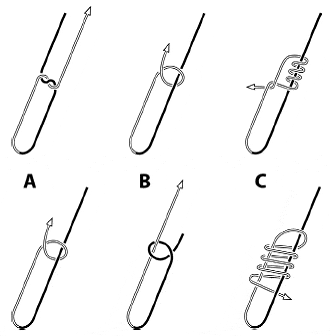
Figure 1. (A) Changing the overhand knot (top) into a half-hitch (bottom) by putting tension on one end is the simplest example of capsizing a knot. (B) Flipping a half-hitch from one end of the suture (top) to the other end (bottom). (C) Changing the sequence of turns of the working end around the standing part (top), into the proper Half Blood Knot geometry (bottom) is an example of flyping.
Materials and Methods:
A literature review was performed using Springerlink, Pubmed, Highwire press, search engines like Google, and Yahoo. The following search terms were used: extracorporeal knot, laparoscopic knots, laparoscopic tissue approximation, Roeder's knot, Meltzer's knot, Weston knot, Duncan knot, Nicky's knot, SMC knot, Tennessee knot. 51032 citations were found. Selected papers were screened for further references. Publications that featured illustrations of sliding knots , comparing between different extracorporeal knots and suture materials, Knots tied with and without a series of 3 RHAPs. with statistical methods of analysis, were selected. More than 22 different sliding knots were used for this review (table 1).
Table 1. Different Sliding Knots in this Review
| Two half-hitches 4 |
| Reversed half-hitches 4 |
| Practical knot (simple version) (10,11) |
| Practical knot (advanced version) (10) |
| Nicky’s knot or taut-line hitch (12,13,14,15,16,17,18) |
| Giant knot (19) |
| Modified tautline hitch (18) |
| Tennessee slider (12,15,20,21,22) |
| Clinch knot, (23) Wendel Knoten,(24) and Vale knot (25) |
| Locking knot (26) |
| Secure knot (27) |
| Tonsillectomy knot (13) |
| Noose loop (28,29) |
| Duncan loop, (23) blood slipknot, (30) hangman’s knot,(31) easy loop,(32) ordura knot (33) |
| Triad knot (34) |
| Three-twist knot (35) |
| Figure-of-eight noose (13) |
| Hangman’s knot (13) |
| Hangman’s tie (36) |
| Mid-ship knot (37) |
Definitions
Post limb: the straight portion of the suture limb purely defined as the suture limb under the most tension
Wrapping limb: the free portion of the suture limb that wraps around the post limb
Effective knot: possesses the attributes of both knot security and loop security
Knot security: the effectiveness of a knot to resist slippage when load is applied
Loop security: the ability of a knot to maintain a tight suture loop as a knot is tied (38,39,40,41,42,43,44)
Knot Configurations
A. Half-Hitches
Half hitch is the simplest of all sliding knots formed by wrapping the suture limb once around the post limb. Named according to the position of the wrapping limb relative to the post limb as viewed by the surgeon during knot tying, Figure (2,3,4).
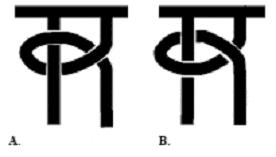
A. Under-over
B. Over- under
Figure 2. half hitches
Reversed half hitches refers to two sequential half hitches tied in reversed direction on the same post.

Reversed half hitches on same post
Figure 3. Reversed half hitches on same post
Reversed half hitches on alternating posts (RHAP) refers to two sequential half hitches formed in reversed directions around the opposite post. RHAPs are commonly used to lock a sliding knot in place. (38,39,40,41,42,43,44,45)
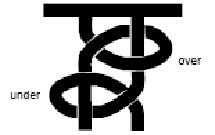
Reversing half-hitch and alternating posts
Figure 4. Reversing half-hitch and alternating posts
Two half-hitches as an extracorporeally tied sliding knot could be intracorporeally advanced, tightened, and pulled back to a flat granny knot during laparoscopic procedures (Fig. 5A). extracorporeally tied sliding reversed half-hitches equally could be reversed back intracorporeally to a flat square knot (Fig. 5B, Table 2). (4)
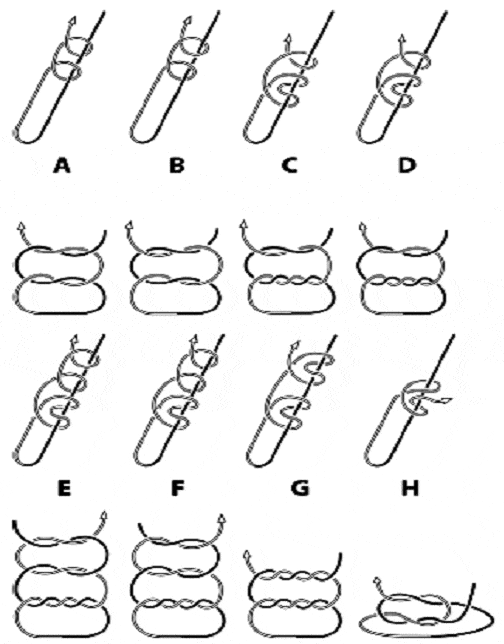
Figure 5. Numerous sliding knots (top row) represent the capsized geometry of flat knots (bottom row). Two half-hitches as such, are a capsized granny knot (A), reversed half-hitches a capsized square knot (B), the simple version of the practical knot a capsized surgeon’s knot (C), Nicky’s knot a capsized granny-wise surgeon’s knot (D), the advanced version of the practical knot a capsized granny-wise surgeon’s knot with an additional reversed half-hitch (E), and the giant knot a capsized grannywise surgeon’s knot with an additional half-hitch (F). Equally, the modified taut-line hitch is a capsized granny-wise tree surgeon’s hitch (G) and the Tennessee slider, a capsized whatknot (H). All these flat knots can also be capsized by tension on the left end instead of the right, but this will result in an identical capsized geometry.
Table 2. Flat Knots That Can Be Capsized Either Way* Into a Sliding Endoscopic Knot

B. Commonly used compound sliding knots
Compound sliding knots have more than one turn of the wrapping limb around the post (i.e. any sliding knot other than a half hitch). Can be used in situations where the suture slides smoothly and freely through the tissue and anchoring device. Advantageous since compound sliding knots can be made to slide down the post limb without unraveling or jamming prematurely. Theoretical disadvantages include abrasion of suture against the anchor eyelet, suture cutting through tissue as it slides. (46,47,48,49,50,51,52,53,54)
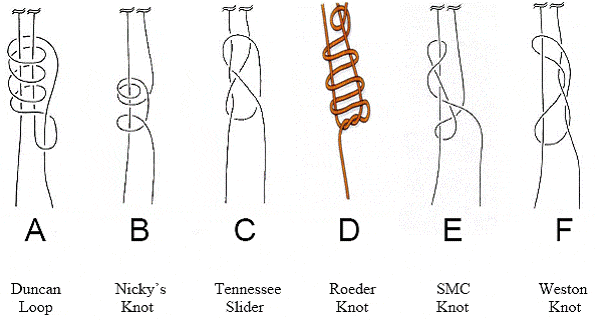

G H
Figure 6. different types of sliding knots





